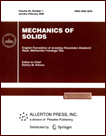 | | Mechanics of Solids
A Journal of Russian Academy of Sciences | | Founded
in January 1966
Issued 6 times a year
Print ISSN 0025-6544
Online ISSN 1934-7936 |
Archive of Issues
| Total articles in the database: | | 13362 |
| In Russian (Èçâ. ÐÀÍ. ÌÒÒ): | | 8178
|
| In English (Mech. Solids): | | 5184 |
|
| << Previous article | Volume 60, Issue 4 / 2025 | Next article >> |
| A. Alansari, "Fractional Three-Phase-Lag Heat Transfer Model for Analyzing Perfect Conducting Thermelastic Hollow Cylinder," Mech. Solids. 60 (4), 2858-2873 (2025) |
| Year |
2025 |
Volume |
60 |
Number |
4 |
Pages |
2858-2873 |
| DOI |
10.1134/S0025654425600977 |
| Title |
Fractional Three-Phase-Lag Heat Transfer Model for Analyzing Perfect Conducting Thermelastic Hollow Cylinder |
| Author(s) |
A. Alansari (Department of Mechanical Engineering, College of Engineering, Northern Border University, Arar, Saudi Arabia, abdulkarim.alansari@nbu.edu.sa) |
| Abstract |
This study presents a unified fractional three-phase-lag heat conduction model within the
framework of Green–Naghdi thermoelasticity, formulated to describe the coupled magneto-electro-thermoelastic response of a perfectly conducting, infinitely long hollow cylinder subjected to a uniform axial magnetic field. The model introduces fractional-order derivatives to generalize classical and
generalized thermoelastic theories (e.g., Biot, Lord–Shulman, GN types I–III) as limiting cases.
A single fractional formulation governed by three phase-lag parameters enables a seamless transition
across different heat transport behaviors while capturing nonlocal and memory effects. Field equations are derived using Laplace transforms and solved semi-analytically. Numerical inversions provide
time-domain distributions of temperature, stress, displacement, and induced electromagnetic fields.
Results show that the fractional order significantly influences thermal and mechanical wave propagation, suppressing displacement while amplifying induced magnetic fields. The model offers new
insight into the thermal response of materials with memory, and the unified structure supports broader
applicability in material characterization and advanced engineering systems. |
| Keywords |
Magneto-thermoelasticity, Generalized Green-Naghdi theories, Infinite hollow perfect conducting cylinder, Fractional calculus |
| Received |
02 March 2025 | Revised |
15 May 2025 | Accepted |
16 May 2025 |
| Link to Fulltext |
|
| << Previous article | Volume 60, Issue 4 / 2025 | Next article >> |
|
 If you find a misprint on a webpage, please help us correct it promptly - just highlight and press Ctrl+Enter If you find a misprint on a webpage, please help us correct it promptly - just highlight and press Ctrl+Enter
|
|

 Russian
Russian  English
English